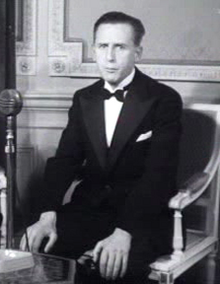The BBC: The First Fifty Years by Asa Briggs shows how radio and TV developed inside the BBC. Chapter V: Sound and Vision, describes how sound broadcasting was once dominant over TV, but how, eventually, TV began to overtake it.
The book details some of the important developments that allowed this to happen such as:
-In 1948, the number of television licences purchased by the public increased to 45,564 before doubling the next year to 126,567.
-The Beveridge committee's report which stated that television was the medium of the future.
-In June 1953, Queen Elizabeth II's coronation was televised, making it one of the first of the great 'media events'.
-There were one million television sets in 1951 compared to over five million in 1955. It was beginning to be seen as an essential for every home.
-BBC's television monopoly was broken by the Conservative Government's Television Act of 1954.
-Hours of news shown on TV more than doubled in 1954/5 and in July 1954 visual news began showing on TV.
-The beginning of commercials where religion or politics could not directly advertise and advertisers messages had to be separate from the TV programmes.
-However, on 22 September 1955, when over eight million people tuned into the light programme to listen to The Archers upon the death of Grace Archer, the dominance of sound broadcasting was shown once again. There was even more press coverage about Grace's death than about the Guildhall speech of the first ITA Chairman or television's first advertisements.
-Colour transmissions began in 1956/7 and the BBC's second channel began to operate in 1957/58.
-The first broadcasted general election was in 1959.
The key figures in these developments were:
 < William Haley, the Director-General of the BBC from 1944-1952. He believed more in the future of sound broadcasting than television, so set up the Third Programme (now known as BBC Radio 3).
< William Haley, the Director-General of the BBC from 1944-1952. He believed more in the future of sound broadcasting than television, so set up the Third Programme (now known as BBC Radio 3).
-Lord Beveridge, the Chairman of the Beveridge committee which ran from June 1949-1951.
-Norman Collins, who campaigned for commercial television to begin in Britain and helped set up ITV (Independent Television) in 1955.
-Cecil McGivern, who is credited as being the 'true architect of BBC TV' as he helped to start a system making it able to plan programmes further in time than ever before in January 1948.
About the Author:
 Asa Briggs was born on 7 May 1921 and died on 15 March 2016 at age 94. He attended the University of London where he studied economics before becoming an English historian with a main focus on the Victorian era. This was the subject of many of his books including Victorian Cities and A Social History of England, but he also wrote books on the history of broadcasting including The BBC:The First Fifty Years. He had two sons and two daughters with his wife Susan Anne Banwell, who he married in 1955.
Asa Briggs was born on 7 May 1921 and died on 15 March 2016 at age 94. He attended the University of London where he studied economics before becoming an English historian with a main focus on the Victorian era. This was the subject of many of his books including Victorian Cities and A Social History of England, but he also wrote books on the history of broadcasting including The BBC:The First Fifty Years. He had two sons and two daughters with his wife Susan Anne Banwell, who he married in 1955. References:
Briggs, A. (1985). The BBC: The First Fifty Years. Oxford: Oxford University Press. pp. 241-296.

Comments
Post a Comment